How to Reflect on Your Teaching
Teaching and learning situations are complex and dynamic experiences (step 1). Becoming aware of—and better understanding—different aspects of your teaching practice requires a sustained disposition to reflect across several iterations or cycles of reflection (step 2).
Reflection can start simply as stating your beliefs and description of how or what things are (step 3). Like someone looking into a mirror, the outcome of this process can promote an increased awareness of your beliefs or assumptions about teaching and your role as the teacher.
With a more complete representation of their own ideas about teaching, instructors who feel ready can use the Framework for Effective Teaching to systematically and purposefully verify the coherence between their beliefs or plans and their actual teaching practices (step 4).
Once instructors verify the integrity of focused aspects of their implementations, instructors can compile additional information to verify whether their intended outcomes were attained and evaluate these results (step 5).
Using these first processes of reflection, labelled as steps 3—5, instructors can identify potential areas of growth in their courses and themselves. Every cycle of reflection provides opportunities to improve instructors’ teaching skills, knowledge, and overall competence. Regardless of depth (i.e., how many steps into the process you undertake), instructors will never come out the same, when reflections are purposeful and sincere.
Finally, some instructors will be ready to explore, formulate and carry out new solutions, and to purposefully modify or seek to innovate different aspects of their teaching practices (step 6). Once these innovations are implemented we recommend that instructors continue to document, verify, and evaluate the effectiveness of their improved teaching practices. We also encourage these instructors to engage in scholarly discussions by sharing their innovations, experiences, and their results with their reflective teaching peers.

The Process of Reflection
The process of reflection may start before, during, or after a teaching experience.
- When instructors decide to engage in reflective practice before a teaching experience, their focus is typically on their strategic planning, expectations, and goals. The purpose of reflection at this stage is for instructors to state and review their philosophical principles, their beliefs, and the theories which precede the situation and inform its goal setting and strategic planning. When reflecting before a teaching experience, instructors anticipate and document what they expect the situation will be, their goals for instruction, their strategic planning, and their ideas about how to teach.
- When instructors reflect while teaching, their reflections are referred to as “reflection-in-action,” (Russell, 2018). Instructors who document their reflection in practice, compile precious information for reflection by documenting their perceptions, ideas, and solutions while teaching. The focus of reflections-in-action are “those unexpected events which can trigger significant reframing of their practice and inspire new courses of action.” (2018, p. 7).
- A reflection conducted after a teaching experience is referred to as “reflection-on-action” (Farrell, 2018). The purpose of this type of reflection may be to increase an instructor’s awareness and understanding of the situation, to verify their implementation, and/or to evaluate its results and identify potential areas of growth: what happened in a lesson, how it evolved, and whether its intended outcomes were attained.
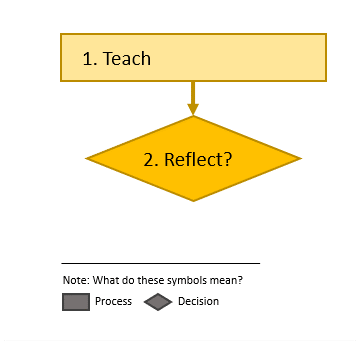 To engage in reflective practice, instructors need to be open and have good reasons to engage in reflection. Instructors who want to learn more about this might want to have a look at our “Why Reflect on Your Teaching” page.
To engage in reflective practice, instructors need to be open and have good reasons to engage in reflection. Instructors who want to learn more about this might want to have a look at our “Why Reflect on Your Teaching” page.
The outcome of this first step can be a simple declarative statement. As such, this step might be considered complete when instructors become aware of and are able to articulate their own reasons for reflecting, for deciding to learn more about and for embracing a regular and deliberate reflective teaching practice.
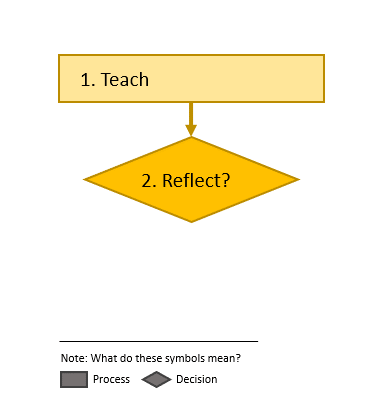 Once instructors have decided to reflect, instructors should tell their story, describing what or how things are from their perspective. This step is not intended to focus on what ought to be or on best practices but on a plain and honest description of the teaching and learning situation.
Once instructors have decided to reflect, instructors should tell their story, describing what or how things are from their perspective. This step is not intended to focus on what ought to be or on best practices but on a plain and honest description of the teaching and learning situation.
The natural outcome of this process should be an increased awareness of one’s own understanding of the situation. An increased awareness can enable instructors to enhance their personal and professional growth and development, allow instructors to identify important issues and gain more confidence in their practice (Farrell, 2018, 2013).
Once instructors have told their story, their own beliefs and thoughts about teaching become objects which can be reflected on.
This first step can be considered complete once instructors have a clear and explicit description of what happened (or will happen), what they tried to achieve, what they planned to do, and what results or outcomes were expected (or obtained). Instructors can continue describing their teaching situation and increasing their awareness of their own perceptions of the situation through repeated cycles of teaching and reflective awareness.
Instructors who feel ready might consider systematically reviewing how coherent or aligned are their beliefs and different aspects of their actual teaching practice. These instructors can validate the coherence between what they say and what they do (for more information, see step 4).
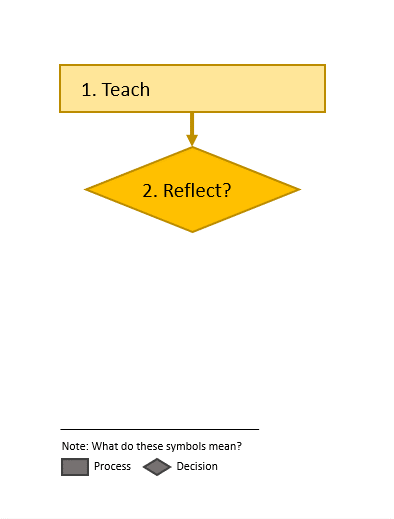 Once instructors have a complete representation of their own ideas about teaching, instructors who feel ready can seek to promote a deeper understanding of their teaching practice by reviewing the coherence systematically and purposefully between their beliefs and actual teaching practices.
Once instructors have a complete representation of their own ideas about teaching, instructors who feel ready can seek to promote a deeper understanding of their teaching practice by reviewing the coherence systematically and purposefully between their beliefs and actual teaching practices.
To help instructors identify which aspects of their courses or teaching practice to focus on, instructors are encouraged to revisit and review their own descriptions of their teaching (for more information, see step 3) to identify or extract a set of strengths, weaknesses, opportunities, and threats.
Once instructors categorize their own ideas about teaching into strengths, weaknesses, opportunities, and threats, instructors can use the Framework for Effective Teaching to identify which specific thematic aspects or parts of their courses or of their teaching to reflect on, how to reflect on these aspects, and what strategies to use to collect relevant information on which they can reflect. The general recommendation is to start small, to focus only on one aspect at a time to allow oneself to learn to reflect.
When compiling relevant information, instructors will focus on describing the set of efforts and actions, objectives, learning tasks and activities, or the quality and number of its resources and materials. Instructors can compile this type of information by directly or indirectly recording or documenting those aspects on which they decided to reflect. For this purpose, instructors might use one or more different sources to observe these aspects, such as recording their own observations, collecting students’ perceptions and opinions, or their peers’ or other observers external to their teaching.
When the analysis shows coherence between what is said and what is done, instructors can go back to teaching and continue to verify the coherence of their implementation with this type of reflective analysis. Instructors who feel ready might also delve deeper and evaluate the results or outcomes of their teaching or of their courses (for more information, see Step 5).
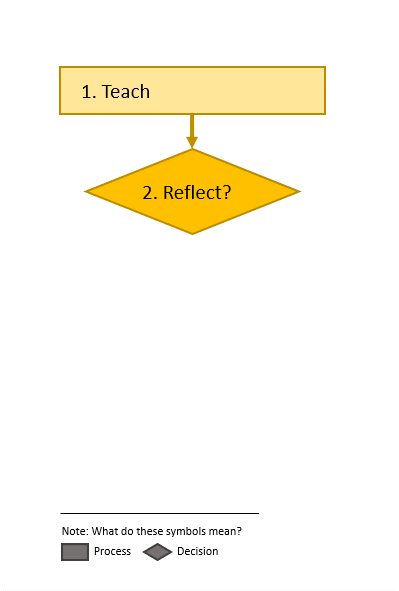 An evaluation starts with a clear description of what instructors were trying to achieve through the course and their teaching, and continues with a compilation of data from a selection of measures, revising and annotating this information, and evaluating what it means for themselves and their future practice.
An evaluation starts with a clear description of what instructors were trying to achieve through the course and their teaching, and continues with a compilation of data from a selection of measures, revising and annotating this information, and evaluating what it means for themselves and their future practice.
An evaluation of results has practical and affective or emotional consequences. From an affective perspective, it is important for instructors to become aware of their own reactions to their results. For this purpose, instructors can ask themselves: What do these results mean? Why do I think those results were obtained? To what can these results be attributed? How do these results make me feel? What is my reaction to these results, do I feel defensive or adaptive?
Considering the results obtained and given their affective reactions, from a practical perspective, instructors can identify opportunities by considering for themselves what they think they should start, stop, and continue doing in their teaching or aspect of the course observed (Hoon et al., 2015).
This process is complete once instructors self-evaluate by comparing the results to their stated goals and evaluate these results from a practical and an affective perspective. Those instructors who feel ready will then seek to purposefully modify or seek to innovate different aspects of their teaching practices (for more information, please see Step 6).
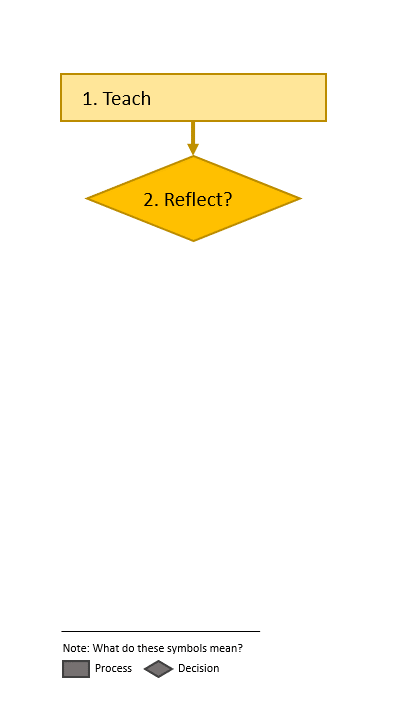 It may be expected for instructors to identify potential areas of growth in their courses and in themselves through all previous steps of reflection (3. awareness, 4. verification, and 5. evaluation). Every cycle of reflection provides opportunities to improve.
It may be expected for instructors to identify potential areas of growth in their courses and in themselves through all previous steps of reflection (3. awareness, 4. verification, and 5. evaluation). Every cycle of reflection provides opportunities to improve.
Some instructors will be ready to further explore, formulate, and carry out new solutions to purposefully modify or seek to innovate different aspects of their teaching practices.
Once instructors realize there is an opportunity for growth (things to start, stop, or continue), the nature of the problem can be represented by stating its most important elements and the patterns of relationships among these elements.
Once instructors are satisfied with their understanding of the issue and possess sufficient relevant information, a solution or a set of solutions can be devised. The instructor can then evaluate each solution and discern which one is feasible to carry out.
Once instructors start carrying out a solution, they will be starting a new cycle of teaching and reflection. Some instructors may also decide not to carry out the solution. Either way, instructors should return to teaching with a more complex understanding of their course, and of teaching and learning.
If you are interested in learning more about this subject, you can find these and other resources related to the Framework for Effective Teaching in our reading list on our Libraries Reading List Service.
Farrell, T. S. C. (2015). Promoting Teacher Reflection in Second Language Education: A Framework for TESOL Professionals. New York: Routledge. https://doi.org/10.4324/9781315775401
Farrell, T. S. C. (2020). Professional development through reflective practice for English-medium instruction (EMI) teachers. International Journal of Bilingual Education and Bilingualism, 23:3, 277-286. https://doi.org/10.1080/13670050.2019.1612840
Russell, T. (2018). A teacher educator’s lessons learned from reflective practice, European Journal of Teacher Education, 41:1, 4-14. https://doi.org/10.1080/02619768.2017.1395852
Snowman, J., & McCown, R. (2011). Psychology applied to teaching. Nelson Education.
Wass, R. & Rogers, T. (2021). Using video-reflection and peer mentoring to enhance tutors’ teaching. Innovations in Education and Teaching International, 58:1, 36-46, https://doi.org/10.1080/14703297.2019.1695646
Zimmerman, B. J. (2008). Investigating self-regulation and motivation: Historical background, methodological developments, and future prospects. American Educational Research Journal, 45(1), 166-183. https://doi.org/10.3102%2F0002831207312909
Zimmerman, B. J., & Labuhn, A. S. (2012). Self-regulation of learning: Process approaches to personal development. APA Handbooks in Psychology. APA Educational Psychology Handbook, Vol 1: Theories, constructs, and critical issues, 399-425. American Psychological Association (APA). https://doi.org/10.1037/13273-014